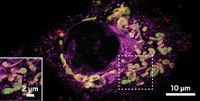Advertisement
Grab your lab coat. Let's get started
Welcome!
Welcome!
Create an account below to get 6 C&EN articles per month, receive newsletters and more - all free.
It seems this is your first time logging in online. Please enter the following information to continue.
As an ACS member you automatically get access to this site. All we need is few more details to create your reading experience.
Not you? Sign in with a different account.
Not you? Sign in with a different account.
ERROR 1
ERROR 1
ERROR 2
ERROR 2
ERROR 2
ERROR 2
ERROR 2
Password and Confirm password must match.
If you have an ACS member number, please enter it here so we can link this account to your membership. (optional)
ERROR 2
ACS values your privacy. By submitting your information, you are gaining access to C&EN and subscribing to our weekly newsletter. We use the information you provide to make your reading experience better, and we will never sell your data to third party members.
Polymers
Tracking polymerization with laser focus
Microscopy method follows copolymer growth in real time at the level of individual monomers
by Brianna Barbu
November 21, 2023

Researchers at Cornell University have devised a new single-molecule microscopy method for studying polymers as they grow (Nat Chem. 2023 DOI: 10.1038/s41557-023-01363-2). “We see every monomer,” says Peng Chen, who led the work.
Chen and his team accomplish this by tethering every monomer to a masked fluorescent dye that can be unquenched using a laser, then imaged and bleached with a different laser. By timing the laser pulses correctly, they are able to see monomers being added to surface-tethered polymer chains, one by one. They call the method CREATS, short for “coupled reaction approach toward super-resolution imaging.”
CREATS can track individual polymers as they grow through hundreds of sequential monomer additions. “In principle, we can follow it for as long as we want,” says Chen, though realistically the experiments are limited by time and data storage capacity.
The researchers used their method to study the kinetics of ring-opening metathesis polymerization (ROMP). They found that interactions with the surface slow down the reaction at the beginning of the polymerization, but monomer addition reaches a steady rate once the chain is about 20 nm long. When they looked at a copolymerization with 2 different monomers, each tagged with a distinct fluorescent label, they found that the sequence isn’t completely random. It’s slightly biased toward the next monomer added to the chain being the same as the one before it, leading to repeated segments.
In an email, Hao Shen of Kent State University calls the method “ingenious” and says he anticipates that many other researchers will want to try CREATS. Chen says his group has only looked at ROMP processes so far, but the method should work for any chain-growth polymerization mechanism.





Join the conversation
Contact the reporter
Submit a Letter to the Editor for publication
Engage with us on Twitter